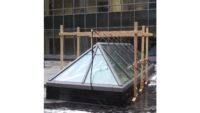Updated Recommendations for Gypsum Panel Product Repairs

As the technical, promotion, and information center of the gypsum industry, the Gypsum Association (GA) regularly revises its publications to reflect technological advances, clarify ambiguities, and respond to questions from the public. Updates to both GA-221 Repair of Joint Ridging and GA-222 Repairing Screw or Nail Pops fall into the latter category. Each set of recommendations clarifies best practices associated with common wallboard repairs.
Joint ridging, or beading, is a uniform, fine linear deformation that can occur at the joints of finished and decorated gypsum panel products. Compression at the edges or ends of the panels due to extreme fluctuations of temperature and humidity is the most common cause of ridging; however, misaligned framing can also contribute to the problem. Whatever the case, repairs of joint ridging should be undertaken only after a wall or ceiling system has stabilized. The Gypsum Association recommends waiting until a new structure has experienced at least one complete heating/cooling cycle before making repairs.
Fastener popping, or the protrusion of screw or nail heads above the gypsum panel surface, can be the result of improper application or fastening. However, the most common source of popping is lumber shrinkage due to initially high moisture content in newly constructed wood framing. Overly long fastener length contributes to the problem. While fastener popping that appears before or during finishing and decoration should be repaired immediately; popping that occurs a month or more into the heating season should wait for repair until the season's end.
In the case of fastener popping, the secure reattachment of the gypsum panel product to the framing is essential. Again, all new screws or nails should be of the proper length. Key to the repair methods outlined in both GA-221-14 and GA-222-14 is careful sanding and treatment with joint compound as well as observing recommended drying times prior to redecoration.
Both documents are included in the GA’s free download library.
Looking for a reprint of this article?
From high-res PDFs to custom plaques, order your copy today!








